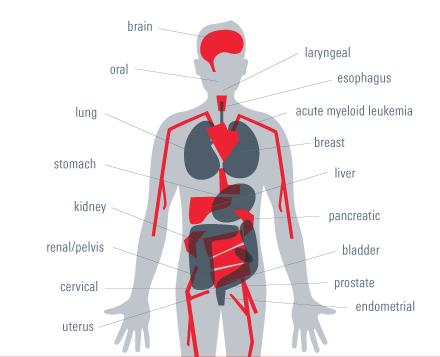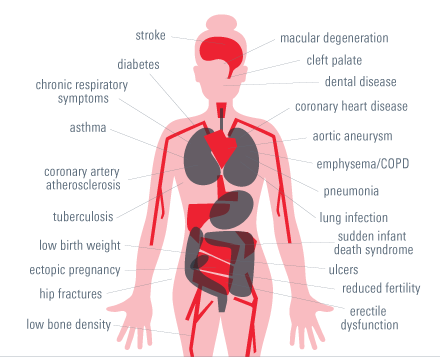Cigarettes
When a cigarette is lit, smoke is inhaled deep into the lungs. This smoke contains thousands of harmful chemicals, 70 of which are linked to cancer. Some of these chemicals come from the plant itself, such as nicotine, a natural pesticide, or while the plant is cured, such as nitrosamines. When cigarettes are smoked, heavy metals, such as cadmium and lead, are also released into the body with the smoke.
Once inside your body, these chemicals cause cancer, heart disease, lung disease, stroke, reduced fertility, nicotine addiction, and many other types of damage, both immediate and long-term.
Secondhand smoke can be just as harmful to nonsmokers.
Smokeless tobacco
Smokeless tobacco includes chewing tobacco, snuff and snus. Chewing tobacco comes in the form of loose leaf, plug or twist, and is placed between the cheek and gums. Some of them are placed in the mouth and others are inhaled through the nose. In Utah, 2.9% of adults use smokeless tobacco, and 3.9% of Utah youth have tried it. Smokeless tobacco is not a safe substitute for smoking cigarettes. It contains nicotine and 28 cancer-causing agents. Youth who use smokeless tobacco are more likely to become cigarette smokers. Rural areas typically have higher smokeless tobacco use rates than urban areas. It might be smokeless, but it still has plenty of danger.
Hookah
Hookahs are water pipes that are used to smoke specially made flavors. They are typically smoked in groups, passing the same mouthpiece from person to person. The smoke contains several toxic agents known to cause lung, bladder and oral cancers. It might seem fun, but it has most of the same risks of cigarettes. And because of the way a hookah is used, smokers may absorb more of the toxic tobacco substances than cigarette smokers do. Hookahs also produce secondhand smoke, which can be a serious health risk for nonsmokers.
E-cigarettes & Vapes
With fun names, bright colors and sleek packaging, vapes are designed to look appealing. Don’t be fooled—they’re full of nicotine and can be highly addictive. Vapes and e-cigarettes heat a liquid that contains harmful chemicals into an aerosol, which is then inhaled. This liquid is sold in irresistible flavors, which helps a dangerous product appear deceivingly harmless. 99% of e-cigarettes contain nicotine, making them highly addictive.
The Facts
In Utah, approximately 10.5% of high school students report using vapes; that’s 5x more than 2011. Approximately 4.8% of Utah adults use vapes. Rather than helping to reduce the number of smokers, vape products are increasing the overall number of people who use tobacco products in the United States, according to a recent CDC report. E-cigarettes and vapes have not been approved by the CDC as a cessation device.
Cigars
A cigar is a roll of tobacco wrapped in leaf tobacco, unlike cigarettes, which are wrapped in paper. There are three types of cigars sold in the United States: large cigars, cigarillos and little cigars. Cigars contain the same toxic and carcinogenic compounds found in cigarettes and are not a safe alternative to cigarettes. In 2015, more high school boys in the United States smoked cigars than cigarettes.

